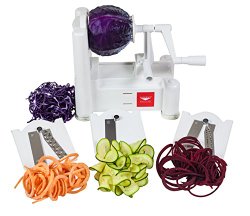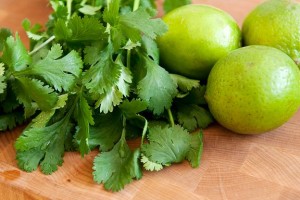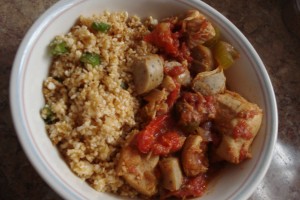This summer, my dad planted butternut squash with my encouragement (and my placing a pack of seeds in his hand), and it has turned out to be a very rewarding harvest. Butternut squash is typically quite expensive at your average grocery store, and so having a supply in the back yard has excellent financial advantages. It has also lead to the discovery that butternut squash makes a wonderful noodle substitute when put through the Spiralizer.

 I first got my Spiralizer last year, and I did use it on a butternut squash once when I had managed to pick one up on sale at Aldi. It worked just as well, of course, but the preparation of the squash as a bit labor-intensive (peeling takes a good while, and then the seeds need to be scraped out like a pumpkin), and since its availability was limited to the occasional grocery store sale, I didn’t spiralize one again. I just stuck to spiralizing zucchini.
I first got my Spiralizer last year, and I did use it on a butternut squash once when I had managed to pick one up on sale at Aldi. It worked just as well, of course, but the preparation of the squash as a bit labor-intensive (peeling takes a good while, and then the seeds need to be scraped out like a pumpkin), and since its availability was limited to the occasional grocery store sale, I didn’t spiralize one again. I just stuck to spiralizing zucchini.
But now that I have a quantity of squash from the back yard, I’ve taken to greater experimentation. The preparation of the squash is still a bit annoying what with the peeling and the seeds, but one medium-sized squash yields quite a bit of spiralized noodles. It’s worth the effort in a way that, for me, peeling several potatoes is not. Unlike other types of hard winter squash, the butternut has a lot of flesh in its thick neck; the seeds are only the lower bulb. The neck spiralizes beautifully, and the bulb can be spiralized once the seeds and pulp are all cleaned out, though sometimes it doesn’t work as well because there’s no flesh in the middle to go through the corer to help stabilize the vegetable.
 I’ve been using spiralized squash so often, that I have taken to calling them “squ-oodles”; I’ve used them in my Pad Thai recipe, I’ve used them in Mornay, I’ve used them with an Italian-style vegetable and tomato sauce. The next logical thing was to attempt a squ-oodle substitution for Macaroni & Cheese.
I’ve been using spiralized squash so often, that I have taken to calling them “squ-oodles”; I’ve used them in my Pad Thai recipe, I’ve used them in Mornay, I’ve used them with an Italian-style vegetable and tomato sauce. The next logical thing was to attempt a squ-oodle substitution for Macaroni & Cheese.
Of course, I could have made a cheese sauce and simply served it over squ-oodles, but I wanted to try a low carb version of the traditional baked casserole recipe. My main concern here was the thickening of the sauce. In a traditional Mac & Cheese casserole, flour is used for thickening and the macaroni are partially cooked during the baking time. Squ-oodles start out very firm, but will soften up much more quickly than pasta, so the sauce needed to be thick going in. I recalled from my experiences making curry cuisine that sauces including pureed nuts, such as korma, tend to thicken up more quickly than sauces without. I wondered if using nuts instead of flour would help similarly to thicken the sauce. I also decided that substituting cream cheese for part of the milk/cream in the recipe would give it a decided thickness advantage. Indeed, this sauce turned out plenty thick, so I imagine the nut flour or meal was probably unnecessary, but I will leave it in as an option.
 SARAH’S SQU-OODLES & CHEESE
SARAH’S SQU-OODLES & CHEESE
1 medium butternut squash, spiralized
2 tablespoons butter
2 tablespoons almond flour, almond meal, or crushed nuts (optional)
1 teaspoon minced garlic
1/2 cup light-bodied white wine
4oz of cream cheese
1/2 cup cream or half n half
8 oz sharp cheddar cheese
salt and pepper, to taste
slivered almonds, lightly toasted
Preheat oven to 350. Peel your squash and spiralize the neck. If you want extra leftover squ-oodles, you can also scrape the seeds out of the bulb and spiralize it.
Melt the butter in a medium-small saucepan. If using, add the nut flour, stirring it into the butter to coat. Add the garlic and the white wine and bring to a boil. Allow the wine to simmer until it is reduced by half. Add the cream, cream cheese, cheddar cheese, salt and pepper. Reduce heat to low, cover and allow to melt. When the cheese is mostly melted, process with an immersion blender to smooth out the sauce.
Meanwhile, toast the slivered almonds in an oven-safe bowl. It should take 10 to 15 minutes to get them toasted at 350, but make sure to check every 5 minutes and stir them so that they will get toasted evenly.
Fill a shallow, 9 inch casserole dish with squ-oodles. Place them in the oven dry for about 10 minutes to release a bit of the squash’s natural liquid. Remove casserole of dry squoodles. Stir your cheese sauce into them, just enough to coat. Sprinkle toasted almonds over the top. Bake for 10 to 15 minutes. Baking longer will make the squ-oodles too soft. Serve and enjoy!












